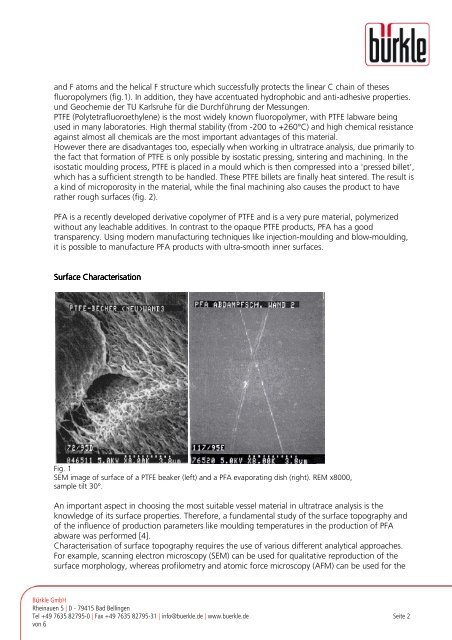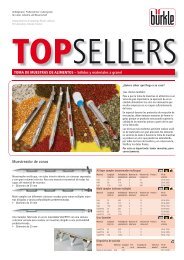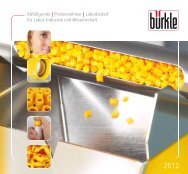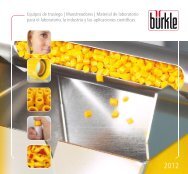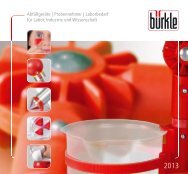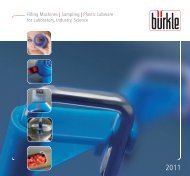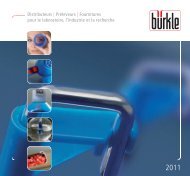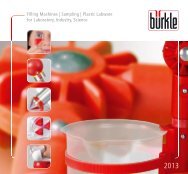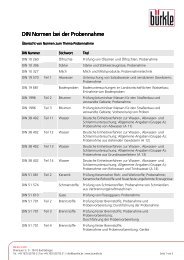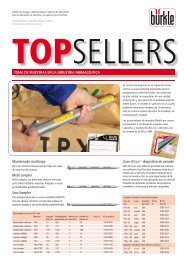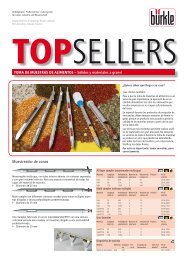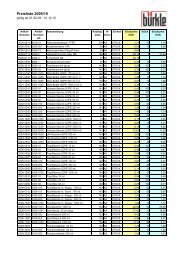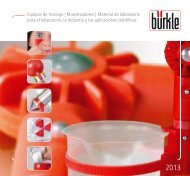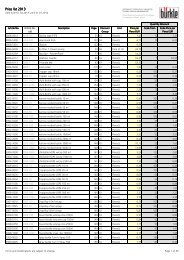Properties of labware from fluorinated hydrocarbons - Bürkle GmbH
Properties of labware from fluorinated hydrocarbons - Bürkle GmbH
Properties of labware from fluorinated hydrocarbons - Bürkle GmbH
Create successful ePaper yourself
Turn your PDF publications into a flip-book with our unique Google optimized e-Paper software.
and F atoms and the helical F structure which successfully protects the linear C chain <strong>of</strong> thesesfluoropolymers (fig.1). In addition, they have accentuated hydrophobic and anti-adhesive properties.und Geochemie der TU Karlsruhe für die Durchführung der Messungen.PTFE (Polytetrafluoroethylene) is the most widely known fluoropolymer, with PTFE <strong>labware</strong> beingused in many laboratories. High thermal stability (<strong>from</strong> -200 to +260°C) and high chemical resistanceagainst almost all chemicals are the most important advantages <strong>of</strong> this material.However there are disadvantages too, especially when working in ultratrace analysis, due primarily tothe fact that formation <strong>of</strong> PTFE is only possible by isostatic pressing, sintering and machining. In theisostatic moulding process, PTFE is placed in a mould which is then compressed into a 'pressed billet’,which has a sufficient strength to be handled. These PTFE billets are finally heat sintered. The result isa kind <strong>of</strong> microporosity in the material, while the final machining also causes the product to haverather rough surfaces (fig. 2).PFA is a recently developed derivative copolymer <strong>of</strong> PTFE and is a very pure material, polymerizedwithout any leachable additives. In contrast to the opaque PTFE products, PFA has a goodtransparency. Using modern manufacturing techniques like injection-moulding and blow-moulding,it is possible to manufacture PFA products with ultra-smooth inner surfaces.Surface CharacterisationFig. 1SEM image <strong>of</strong> surface <strong>of</strong> a PTFE beaker (left) and a PFA evaporating dish (right). REM x8000,sample tilt 30°.An important aspect in choosing the most suitable vessel material in ultratrace analysis is theknowledge <strong>of</strong> its surface properties. Therefore, a fundamental study <strong>of</strong> the surface topography and<strong>of</strong> the influence <strong>of</strong> production parameters like moulding temperatures in the production <strong>of</strong> PFAabware was performed [4].Characterisation <strong>of</strong> surface topography requires the use <strong>of</strong> various different analytical approaches.For example, scanning electron microscopy (SEM) can be used for qualitative reproduction <strong>of</strong> thesurface morphology, whereas pr<strong>of</strong>ilometry and atomic force microscopy (AFM) can be used for theBürkle <strong>GmbH</strong>Rheinauen 5 | D - 79415 Bad BellingenTel +49 7635 82795-0 | Fax +49 7635 82795-31 | info@buerkle.de | www.buerkle.de Seite 2von 6


